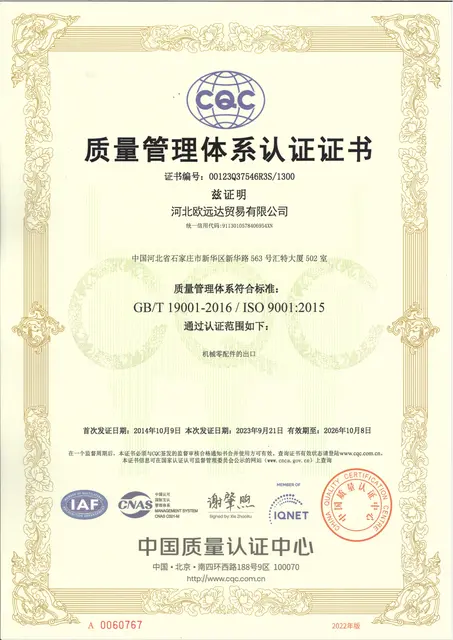Mobile:+86-311-808-126-83
Email:info@ydcastings.com
single vane impeller
Single Vane Impeller Design, Functionality, and Applications
The single vane impeller is a crucial component in various fluid movement and management systems, playing a pivotal role in applications that require efficient fluid transport. Whether it's in pumps, compressors, or mixers, the design and functionality of the single vane impeller significantly influence the performance of these systems.
Design Features
A single vane impeller consists of a single blade extending from a hub, creating a pathway for fluid to be drawn into the impeller and subsequently propelled outwards. The geometry of the vane, including its shape, size, and angle, is meticulously engineered to optimize fluid dynamics. The blade's angle is often designed to enhance the fluid's kinetic energy as it moves through the impeller, ensuring that the velocity and pressure are suitably increased for effective transportation.
The materials used in the construction of single vane impellers are also noteworthy. Often made from metal alloys or high-grade plastics, these materials are chosen for their durability and resistance to corrosion, especially in applications involving aggressive chemicals or varying temperatures. This choice of materials is fundamental, as the impeller must withstand both mechanical stresses and the characteristics of the fluid it handles.
Functionality
The functionality of a single vane impeller is closely linked to its design attributes. When the impeller rotates, the single vane accelerates the fluid outward due to centrifugal force. This movement creates a drop in pressure at the impeller inlet, drawing more fluid into the system. As the fluid travels along the vane and exits at a higher velocity, it gains the energy necessary for transport through pipes or channels.
One of the key benefits of a single vane impeller is its simplicity in design, which can result in lower manufacturing costs and ease of maintenance
. Additionally, the straightforward geometry allows for efficient cleaning and replacement, which is particularly advantageous in sanitary applications, such as food processing or pharmaceuticals, where cleanliness is paramount.single vane impeller

Applications
Single vane impellers find their applications across a broad spectrum of industries. In the water treatment sector, they are used in pumps to move water efficiently through treatment plants. In HVAC systems, single vane impellers facilitate air movement, ensuring effective heating and cooling processes. Furthermore, in chemical engineering, they are utilized in mixers where the homogeneous blending of different substances is essential.
Another notable application is in the automotive industry, where single vane impellers are common in various fluid handling systems. From fuel pumps to cooling systems, their ability to transport fluids efficiently is vital for maintaining optimal vehicle performance.
Advantages
One of the most significant advantages of utilizing a single vane impeller is its efficiency. In comparison to multi-vane configurations, a single vane design can operate at higher speeds with less energy loss, making it an attractive option for energy-conscious applications. Furthermore, the simple design tends to result in less turbulence and friction, leading to improved flow characteristics and reduced wear on the impeller itself.
Moreover, the ease of manufacturing and installation makes the single vane impeller a preferred choice for many engineers and designers. Its modular nature allows for straightforward integration into existing systems, reducing downtime and associated costs.
Conclusion
In summary, the single vane impeller is a vital component in many fluid movement systems, with its design and functionality playing a crucial role in various applications spanning multiple industries. Whether used in pumps, compressors, or mixers, its simplicity and efficiency make it an excellent choice for enhancing fluid transport. As industries continue to seek ways to improve energy efficiency and operational performance, the single vane impeller will likely remain a fundamental element in the design of fluid management systems. Through ongoing innovations and improvements in materials and design techniques, the future of single vane impellers looks promising, ensuring their relevance in an ever-evolving industrial landscape.
-
Why Should You Invest in Superior Pump Castings for Your Equipment?NewsJun.09,2025
-
Unlock Performance Potential with Stainless Impellers and Aluminum End CapsNewsJun.09,2025
-
Revolutionize Your Machinery with Superior Cast Iron and Aluminum ComponentsNewsJun.09,2025
-
Revolutionize Fluid Dynamics with Premium Pump ComponentsNewsJun.09,2025
-
Optimizing Industrial Systems with Essential Valve ComponentsNewsJun.09,2025
-
Elevate Grid Efficiency with High-Precision Power CastingsNewsJun.09,2025











